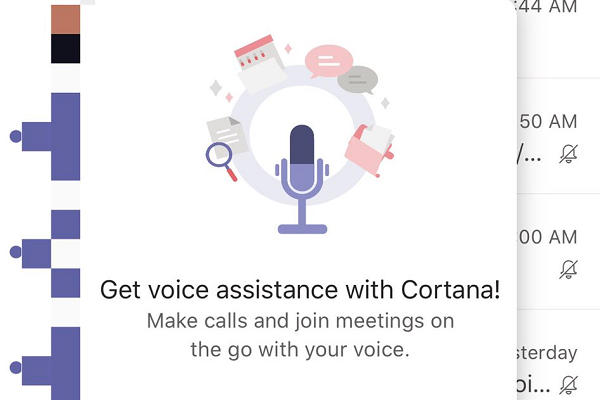Microsoft Will Integrate Cortana into Teams iOS App
 Microsoft will integrate the Cortana voice assistant to the Teams iOS app, according to leaked screenshots first shared on Twitter by Junwei Huang. The addition marks another step in Cortana’s shift toward becoming an aspect of Microsoft’s productivity software.
Microsoft will integrate the Cortana voice assistant to the Teams iOS app, according to leaked screenshots first shared on Twitter by Junwei Huang. The addition marks another step in Cortana’s shift toward becoming an aspect of Microsoft’s productivity software.
Team-Up
Cortana is about to become a business digital assistant, which has now been integrated into Outlook and Teams, no longer a separate program pic.twitter.com/lHX34v7lQC
— wbpluto (@wbpluto) May 19, 2020
Microsoft announced that it was ending support for Cortana as an independent iOS and Android app earlier this year. The only remnant is in the U.S., where the app is part of Microsoft’s Surface Headphones support. Instead of removing the voice assistant entirely from its library, however, Microsoft is folding Cortana into its other apps, including Teams. Cortana will respond to a user’s voice request to make a call or join a meeting from an iPhone. The voice assistant will also be able to handle sharing documents and other data by voice, it seems, presumably by connecting to a Microsoft shared drive in the cloud.
Cortana is already embedded in the iOS Outlook app. Cortana can read out emails and schedule notifications, and users can label or archive them by voice. That update also added a new daily briefing email feature, combining meeting summaries and relevant documents for each day to Office 365 users. With Outlook and Teams, Cortana sets a place as a facet of Office 365, as opposed to the broader functions it offered until recently.
Hidden Changes
Notably, Cortana has been absent from discussion during Microsoft’s Build conference, the massive (though entirely online because of the COVID-19 health crisis) annual event held this week where the tech giant shows off some of its new and upcoming technology and products. Though artificial intelligence is central to many of the announcements the company is making, Cortana has been unmentioned. That’s likely because of how the voice assistant’s role in Microsoft’s ecosystem is still evolving.
Cortana began the move in 2018 when Microsoft launched the Cortana Skills Kit for Enterprise, but the change has accelerated since then. The company is redeploying Cortana into Windows 10, as part of the operating system’s updates this year as a standalone app, not part of the taskbar. That means Cortana won’t be able to handle music and smart home device requests but has yet to materialize fully in its new form. At the beginning of the month, Cortana’s wake word was even taken offline temporarily. Still, with its latest laptops able to act like voice-controlled smart displays, it’s clear Microsoft is waiting for the right time to promote its voice assistant, in its new form, once again.
Follow @voicebotai Follow @erichschwartz
Microsoft Cortana Ends Music and Smart Home Support as Enterprise Shift Continues
Microsoft’s New Surface Book 3 Laptop’s Microphones Make for an Ersatz Smart Display
New Microsoft Patent Shows Cortana Parsing Messages and Context








